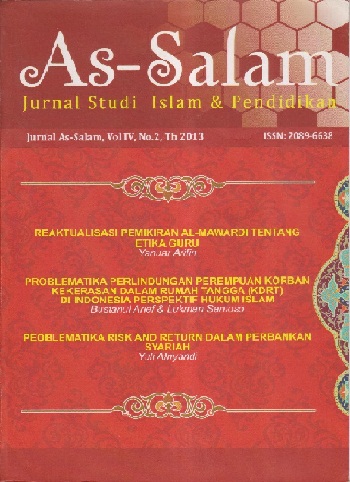PENGGUNAAN ALAT PERMAINAN EDUKATIF UNTUK MENINGKATKAN KREATIVITAS ANAK DI TK
Abstract
In the process of educating at TK (Primary School), one of the main goals
is to develop the creativity of children optimally. It is so important about
developing the creativity of children can be seen from the difference of
the role of the teacher which is early dominating a class, now must give
more a chance to the children to take a more active and creative role in the
comfortable atmosphere and that is supported with supplying educative
games. That dimension is underlying this research.
This research heads for increasing the creativity of children through using
the tools of educative games. Those tools which are used are origami paper,
poster paint, and plastisin. The kind of this research is a research of class
action, because this research is relevant and agrees with the object of
research. The subject of this research is all of the pupils in group BI in TK
ABA I Braja Harjosari, 32 Pupils.
The collecting of data that is collected in this research is observation,
interview/discussion, and documentation. This research is going to act
in cycle I and II around six times meeting. After analyzing and working
through in this research, the writer can take the conclusion that the using
tools of educative games can increase the creativity of the children age 5-6
years. It can be proved with the percentage of !inal learning to cycle I up to
56, 25% and then increasing at the cycle II becomes 71, 87%
Downloads
References
Arikunto, Suharsimi. Penelitian Tindakan Kelas. Jakarta: PT. Bumi Aksara,
Asmawati, Luluk. Dasar-Dasar Pendidikan Anak Usia Dini Secara Islami.
Jakarta: STIT INSID, 2008.
Bahri Djamarah, Syaiful. Psikologi Belajar. Jakarta: Rineka Cipta, 2010.
Departemen Agama RI. Al-Qur’an dan Terjemahnya. Semarang: PT. Karya
Toha, 2011.
Departemen Pendidikan dan Kebudayaan.Kamus Besar Bahasa Indonesia.
Jakarta: Balai Pustaka, 1997.
“mengenal ciri-ciri anak kreatif”, dalam http://www.orangtua.
org/2011/11/20/, diakses pada tanggal 24 Januari 2013, pukul 17.30
WIB.
Ismail, Andang. Education Games. Yogyakarta: Pro-U Media, 2007.
Tim Penyusun, Alat Peraga dan APE. Yogyakarta: Shibyan, 2012.
Kusuma, Wijaya dan Dedi Dwitagama.Penelitian Tindakan Kelas. Jakarta:
Indeks, 2010.
Muslich, Masnur. Melaksanakan PTK Itu Mudah. Jakarta: Bumi Aksara,
Marzuki, A. Choiran. Anak Saleh Dalam Asuhan Ibu Muslimah. Yogyakarta:
Mitra Pusaka, 1999.
Moeslichatoen.Metode Pengajaran Di Taman Kanak-kanak. Jakarta:
Rineka Cipta, 2004.
Syah, Muhibbin. Psikologi Belajar. Jakarta: Raja Gra!indo, 2010
Undang-Undang RI Nomor 20 Tahun 2003 Tentang Sistem Pendidikan
Nasional. Bandung: Citra Umbara, 2003.
Yusuf, Syamsu, dkk, Perkembangan Peserta Didik. Jakarta: PT Rajagra!indo
Pustaka, 2011.
















